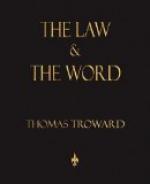Let me start, then, by considering some well established facts in the physical world which show how the known Law acts under certain known conditions, and this will lead us on in an intelligible manner to see how the same Law is likely to work under as yet unknown conditions. If we had to deal with unknown laws as well as unknown conditions we should, indeed, be up a gum tree. Fancy a mathematician having to solve an equation, both sides of which were entirely made up of unknown quantities—where would he be? Happily this is not the case. The Law is one throughout, and the apparent variety of its working results from the infinite variety of the conditions under which it may work. Let us lay a foundation, then, by seeing how it works in what we call the common course of Nature. A few examples will suffice.
Hardly more than a generation ago it was supposed that the analysis of matter could not be carried further than its reduction to some seventy primary chemical elements, which in various combinations produced all material substances; but there was no explanation how all these different elements came into existence. Each appeared to be an original creation, and there was no accounting for them. But now-a-days, as the rustic physician says in Moliere’s play of the “Medecin Malgre Lui,” “nous avons change tout cela.” Modern science has shown conclusively that every kind of chemical atom is composed of particles of one original substance which appears to pervade all space, and to which the name of Ether has been given. Some of these particles carry a positive charge of electricity and some a negative, and the chemical atom is formed by the grouping of a certain number of negatively charged particles round a centre composed of positive electricity around which they revolve; and it is the number of these particles and the rate of their motion that determines the nature of the atom, whether, for instance, it will be an atom of iron or an atom of hydrogen, and thus we are brought back to Plato’s old aphorism that the Universe consists of Number and Motion.
The size of these etheric particles is small beyond anything but abstract mathematical conception. Sir Oliver Lodge is reported to have made the following comparison in a lecture delivered at Birmingham. “The chemical atom,” he said, “is as small in comparison to a drop of water as a cricket-ball is compared to the globe of the earth; and yet this atom is as large in comparison to one of its constituent particles as Birmingham town-hall is to a pin’s head.” Again, it has been said that in proportion to the size of the particles the distance at which they revolve round the centre of the atom is as great as the distance from the earth to the sun. I must leave the realization of such infinite minuteness to the reader’s imagination—it is beyond mine.




